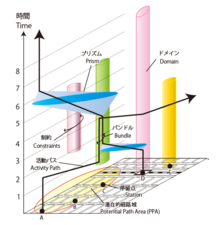

The neighborhood effect averaging problemorNEAP delves into the challenges associated with understanding the influence of aggregating neighborhood-level phenomena on individuals when mobility-dependent exposures influence the phenomena.[1][2][3] The problem confounds the neighbourhood effect, which suggests that a person's neighborhood impacts their individual characteristics, such as health.[4][5] It relates to the boundary problem, in that delineated neighborhoods used for analysis may not fully account for an individual's activity space if the borders are permeable, and individual mobility crosses the boundaries. The term was first coined by Mei-Po Kwan in the peer-reviewed journal "International Journal of Environmental Research and Public Health" in 2018.[1][2]

Mei-Po Kwan, a prominent scholar in human geography, highlighted the importance of accounting for spatial processes and interactions within neighborhoods in a 2018 paper.[2] She argued that the analysis's neighborhood effect averaging problem arises from disregarding spatial dependence and spatial heterogeneity, and is credited with the discovery of the NEAP.[2][6] In studying human geography, understanding the relationship between individual-level attributes and the effects of the neighborhood in which individuals reside is crucial.[4][5] However, a significant issue arises due to the potential mismatch between the scale at which data is collected (individual level) and the scale at which analysis is conducted (neighborhood level).[1] Individual-level data often provide detailed information about individuals, including socioeconomic status, education level, or health conditions. On the other hand, neighborhood-level data offers a broader perspective on specific areas, encompassing factors like average income, crime rates, or access to amenities.[4]
The neighborhood effect averaging problem emerges as researchers attempt to integrate the disparate data scales of individuals and neighborhoods.[1][2] The common approach involves aggregating individual-level data to the neighborhood level by calculating summary statistics such as means or proportions for each neighborhood. However, this oversimplifies the analysis by assuming that individuals within the neighborhood all have activity spaces and space-time paths within the neighborhood's borders. Studies applying the neighborhood effect fail to capture the individual's real neighborhood by failing to consider mobility.[1] A person's mobility may amplify or attenuate environmental factors in their neighborhood.[2]
To address this problem, Kwan proposed utilizing spatial statistical techniques to consider individuals neighborhood contexts at different temporal scales throughout their life.[1] By incorporating these methods, researchers can model and analyze the spatial relationships between individuals and their neighborhoods. Factors such as proximity, spatial autocorrelation, and the influence of neighboring areas can be considered, providing a more accurate understanding of the complex dynamics between individuals and their environment.
By acknowledging and tackling the neighborhood effect averaging problem, researchers can better understand how individual characteristics interact with neighborhood contexts to shape various outcomes, such as health outcomes, educational attainment, or social behavior.[1] This approach advances urban and regional studies knowledge, providing insights into the intricate interplay between individuals and their surrounding environment.[1] Failure to account for the NEAP may lead to erroneous findings.[2]
The NEAP suggests that simply improving neighborhood conditions may not improve an individual's experience. By increasing cross-neighborhood transit and interactions between disadvantaged and advantaged neighborhoods, it may be possible to improve individual outcomes like health.[1][3]